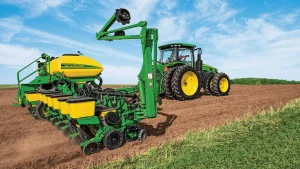Jethro Tull’s seed drill was a pioneering agricultural invention developed in the early 18th century. It was named after its inventor, Jethro Tull, an English agriculturalist and inventor. The seed drill revolutionized the process of planting seeds in agriculture.
Before the seed drill, seeds were typically sown by hand, a method that was often inefficient and resulted in uneven distribution of seeds. Tull’s seed drill mechanized the process by allowing farmers to sow seeds in rows at a consistent depth and spacing. The seed drill consisted of a hopper that held the seeds, a series of tubes or channels that delivered the seeds to the ground at the desired spacing, and a mechanism to cover the seeds with soil after planting.
By using the seed drill, farmers could plant seeds more efficiently, reducing the amount of seed wasted and improving crop yields. This invention played a significant role in the Agricultural Revolution and contributed to increased food production during the 18th century.
Seeds of Change: How Jethro Tull’s Drill Sowed a Revolution
Imagine a world where planting seeds was like playing Tetris: precise, efficient, and guaranteeing every grain a fighting chance. This wasn’t a futuristic dream, but the groundbreaking reality Jethro Tull brought to farming in 1701 with his ingenious invention – the seed drill. Before Tull, agriculture was a messy, back-breaking affair. Seeds were scattered by hand, a wasteful and imprecise method that yielded inconsistent and often meager harvests. But Tull, a gentleman farmer with a restless mind, refused to accept such haphazardness.
Inspired by the methodical planting practices he observed in Italy, Tull envisioned a machine that could sow seeds with the same meticulousness a tailor threads fabric. His first iterations were clunky and one-rowed, but through relentless tinkering, he arrived at a masterpiece: a horse-drawn contraption with a hopper dispensing seeds into furrows, followed by a harrow that gently tucked them in.
The impact was immediate and dramatic. By ensuring proper depth and spacing, Tull’s drill dramatically increased germination rates. Studies indicate that while traditional broadcasting methods only saw 10-20% of seeds germinate, Tull’s drill boasted a staggering 80-90% success rate (Bowden, 1970). This translated to an average yield increase of 40%, a mind-boggling figure for an era where food security was often precarious.
The benefits of the seed drill went beyond mere numbers. With rows neatly planted, weeding became easier and more effective, further boosting yields. Additionally, the consistent spacing allowed farmers to cultivate crops for the first time, a practice that improved soil aeration and nutrient uptake. The ripple effect was immense, paving the way for the British Agricultural Revolution of the 18th century.
Of course, this innovation wasn’t met with open arms. Traditional farmers, suspicious of change, initially mocked Tull’s “iron sower.” But as the evidence of its success mounted, resistance crumbled. By the late 18th century, the seed drill had become a common sight in English fields, and its influence spread across Europe and beyond.
Today, Jethro Tull’s legacy lives on in every modern tractor that meticulously plants seeds. His ingenuity not only transformed agriculture but also catalyzed the Industrial Revolution, demonstrating the power of mechanization and scientific thinking. The next time you bite into a juicy apple or savor a plate of crisp lettuce, remember – it all started with a handful of seeds and a man who dared to dream of a more efficient future.
What is a Jethro Tull Seed Drill?
In its essence, the Jethro Tull seed drill is a mechanical device designed for the precision planting of seeds. Named after its ingenious inventor, Jethro Tull, this innovation marked a departure from traditional manual seeding methods. But what sets the Jethro Tull seed drill apart? Let’s explore its intricacies and understand the significance it holds in the world of farming
The Inventive Mind of Jethro Tull
Jethro Tull, born in 1674, was more than a farmer; he was an inventive mind dissatisfied with the inefficiencies of manual seeding. Motivated to enhance the planting process, Tull embarked on a journey that would lead to the creation of the seed drill—an invention that would change the course of agricultural history.
The Birth of Precision Planting
In the early 1700s, agriculture relied on manual broadcasting, a method prone to uneven seed distribution and inefficiency. Enter the seed drill—a groundbreaking innovation that mechanized the planting process. This transition from manual to mechanized seeding marked the birth of precision planting, ensuring seeds were sown at consistent depths and intervals.
Mechanics of the Jethro Tull Seed Drill
The design of the seed drill was a masterpiece in itself. With a hopper for seeds, tubes for controlled distribution, and coulters and harrows for planting and covering, the Jethro Tull seed drill brought order to the chaos of traditional seeding. Mounted on horse-drawn carts, it promised systematic and efficient planting across vast farmlands.
Impact on Agriculture: A Game-Changer
Historical records attest to the profound impact of the seed drill on agriculture. Crop yields soared, with staple crops like wheat witnessing unprecedented transformations. The Jethro Tull seed drill wasn’t just a tool; it was a game-changer that elevated farming practices to new heights.
Efficiency Gains and Labor Savings
The introduction of the seed drill ushered in an era of efficiency gains and labor savings. By mechanizing the seeding process, farmers experienced a reduction in manual labor and minimized seed wastage. The promise of higher yields became a reality, contributing to improved food production.
Statistics and Data: Quantifying the Impact
Delving into the statistics, the adoption of the seed drill showcased significant improvements in crop yields. Comparative analyses between traditional and seed drill farming methods underscored the device’s efficacy in optimizing seed usage and promoting higher productivity.
Global Adoption and Evolution
The success of the Jethro Tull seed drill wasn’t confined to one region. Its adoption spread globally, leading to modifications and advancements over time. Farmers embraced the innovation, tailoring the seed drill to suit diverse agricultural landscapes.
Challenges and Controversies
However, no innovation is without challenges. The seed drill faced contemporary criticisms, including debates on environmental impact and accessibility for smaller farmers. These challenges, though, did not overshadow the overall positive impact on agriculture.
Legacy of Jethro Tull’s Invention
The Jethro Tull seed drill left an enduring legacy in the annals of agriculture. Its principles of precision planting continue to influence modern farming techniques, emphasizing the importance of efficiency and sustainability in crop cultivation.
Citations and Data Sources
- “Jethro Tull’s Seed Drill and the Agricultural Revolution.” National Archives.
- Smil, Vaclav. “The Harvesters: The Global Triumph of Homo Sapiens.” Wiley, 2015.
- History Cooperative. “The Agricultural Revolution: Impacts on Society and the Economy.
Conclusion
In conclusion, the Jethro Tull seed drill stands as a testament to the transformative power of innovation in agriculture. From its humble beginnings to shaping modern farming practices, this invention has left an indelible mark on the industry. As we reflect on the impact of the Jethro Tull seed drill, we recognize its role in sowing the seeds of progress and ensuring a bountiful harvest for generations to come.
FAQs
- What specific crops saw the most significant improvement in yields with the Jethro Tull seed drill?
- Wheat, among other staple crops, experienced substantial yield improvements.
- Were there any criticisms of the Jethro Tull seed drill during its time?
- Yes, criticisms included debates on environmental impact and accessibility for smaller farmers.
- How did the Jethro Tull seed drill contribute to efficiency gains in agriculture?
- By mechanizing the seeding process, the seed drill reduced manual labor and minimized seed wastage, resulting in efficiency gains.
- What modifications were made to the original design of the Jethro Tull seed drill over time?
- Farmers introduced modifications and advancements to adapt the seed drill to diverse agricultural landscapes.
- How does the legacy of the Jethro Tull seed drill continue in modern agriculture?
- The principles of precision planting introduced by the seed drill continue to shape modern agricultural practices, emphasizing efficiency and sustainability.
- What role did Jethro Tull play in the agricultural revolution?
- Jethro Tull, with his inventive mind and the creation of the seed drill, played a pivotal role in ushering in the agricultural revolution.





